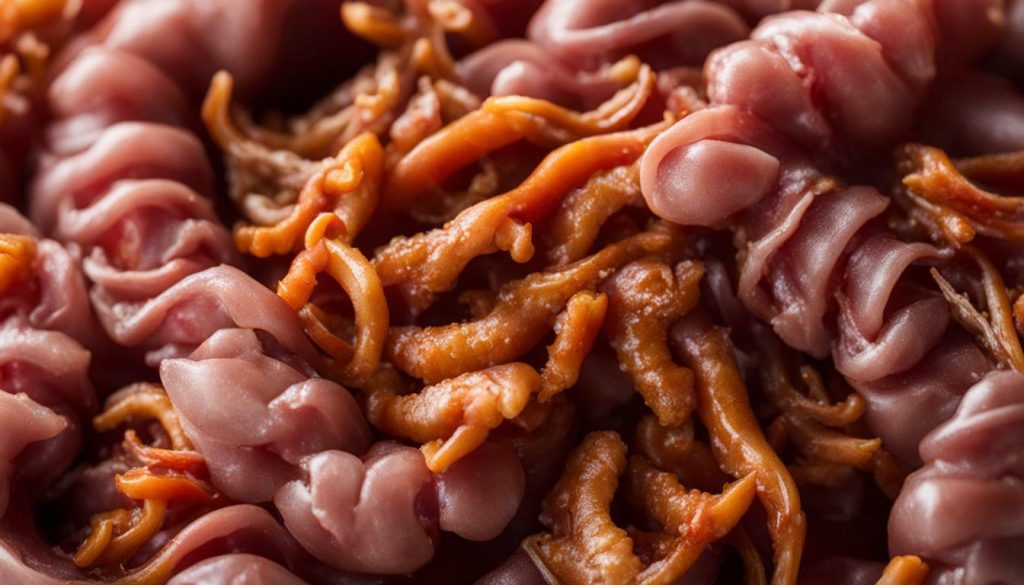If you’re wondering if it’s safe for dogs to eat chicken feet, you’ve come to the right place. Chicken feet are not only safe but also provide numerous health benefits for our furry friends. They are packed with essential nutrients and offer advantages such as joint support and dental hygiene.
Key Takeaways:
- Chicken feet are safe and healthy for dogs to eat.
- They are high in glucosamine and chondroitin, which support good joint health.
- Chewing on chicken feet helps clean a dog’s teeth.
- Chicken feet can be given to dogs in various forms, such as raw, dehydrated, or puffed.
- It’s important to trim the nails on chicken feet to avoid potential issues.
While chicken feet are generally safe, it’s essential to consider your dog’s specific needs and consult with a veterinarian before introducing them or any new treat into their diet. By doing so, you can ensure their well-being and make informed decisions about their nutrition and overall health.
Nutritional Benefits of Chicken Feet for Dogs
Chicken feet can actually be quite beneficial for your furry friend’s overall health. They are packed with essential nutrients that can support their well-being in various ways.
One of the main nutritional benefits of chicken feet is their high content of glucosamine and chondroitin. These compounds are known to promote healthy joints and cartilage in dogs. As dogs age, their joints can become stiff and painful, and the glucosamine and chondroitin found in chicken feet can help alleviate these issues. Regular consumption of chicken feet can improve mobility and reduce the risk of joint-related problems.
Another advantage of chicken feet is their capability to enhance dental hygiene. When dogs chew on chicken feet, the abrasive texture helps remove plaque and tartar buildup, reducing the risk of dental diseases such as gum inflammation and tooth decay. Additionally, chewing on chicken feet can strengthen jaw muscles, improving overall dental health.
To ensure your dog benefits from chicken feet, they can be given in various forms. Some options include raw, dehydrated, or puffed chicken feet. It is important to note that for young puppies with developing teeth, chicken feet may be too hard. In such cases, it is best to consult with a veterinarian for appropriate alternatives.
| Alternatives to Chicken Feet for Dogs |
|---|
| Dental chews |
| Duck feet |
| Pig ears |
| Chicken necks |
| Rabbit ears |
Can dogs eat chicken feet?
In conclusion, chicken feet can be a nutritious addition to your dog’s diet. They provide important health benefits, including joint support and dental hygiene. However, it is crucial to consult with a veterinarian to ensure your dog’s specific dietary needs and preferences are met. With the right guidance, chicken feet can be a safe and tasty treat for your beloved pet.

Did you know that giving your dog chicken feet can help keep their teeth clean and healthy? Chewing on chicken feet can act as a natural toothbrush, helping to remove plaque and tartar buildup. The texture and shape of chicken feet provide a gentle abrasive action, which can help polish your dog’s teeth and promote good oral hygiene.
As dogs chew on chicken feet, the skin, tendons, and cartilage help to scrape away bacteria and food particles that may be stuck in between their teeth. This chewing action also stimulates saliva production, which can help neutralize acids in the mouth and reduce the risk of tooth decay. Additionally, the act of chewing on chicken feet provides mental stimulation and can help satisfy your dog’s natural instinct to chew.

When offering chicken feet to your dog, it is essential to ensure that they are raw or properly cooked. Raw chicken feet are a popular option and can be served as is or dehydrated. Alternatively, you can find cooked and dried chicken feet at pet stores, which are a convenient option for pet owners. It’s important to note that young puppies should avoid chicken feet as they can be too hard for their developing teeth.
To prevent any potential issues, it’s advisable to trim the nails on the chicken feet before giving them to your dog. This step can help eliminate any sharp edges that could cause injury or discomfort. Always supervise your dog while they chew on chicken feet to ensure they are enjoying them safely.
While chicken feet can be a great addition to your dog’s diet, it’s essential to remember that they should be given in moderation. They should not replace a balanced diet but rather be incorporated as a treat or supplement. It’s always best to consult with your veterinarian before introducing chicken feet or any new treat into your dog’s diet to ensure it aligns with their specific health needs.
Safe Ways to Offer Chicken Feet to Dogs
There are several ways you can offer chicken feet to your dog, depending on their preferences and your comfort level. One option is to provide raw chicken feet, which can offer the most nutritional benefits. Raw chicken feet are rich in natural enzymes and provide a good source of glucosamine and chondroitin for joint health. However, some dog owners may feel uncomfortable with the idea of feeding raw food to their pets. If that’s the case, cooked chicken feet can be a suitable alternative.
Cooked chicken feet are safe for dogs to consume, as long as they are thoroughly cooked to kill any bacteria or parasites. You can boil the chicken feet until they become soft and the meat easily separates from the bones. Alternatively, you can also dehydrate the chicken feet to create a chewy treat. Simply place the chicken feet in a food dehydrator or oven on low heat until they are fully dried. This method helps preserve the nutrients while removing moisture.
Tip: When offering chicken feet to your dog, it’s important to consider their chewing capabilities and monitor them closely. Some dogs may struggle with larger chicken feet or have difficulty digesting them. In such cases, it’s best to provide smaller or shredded pieces to prevent choking hazards.
Raw vs. Cooked Chicken Feet: Which is Better?
While both raw and cooked chicken feet can be safely fed to dogs, there are some differences to consider. Raw chicken feet offer the highest nutritional value, as cooking can lead to a loss of certain nutrients. On the other hand, cooking chicken feet can help soften the bones, making them easier for dogs to chew and digest. It ultimately comes down to personal preference and what works best for your dog’s individual needs.
Remember, moderation is key when including chicken feet in your dog’s diet. Treat them as occasional snacks or additions to their regular meals. Always consult with your veterinarian before introducing any new treat or food into your dog’s diet, especially if they have existing health conditions or dietary restrictions.
| Treat Option | Description |
|---|---|
| Raw Chicken Feet | Rich in natural enzymes and nutrients. Beneficial for joint health. |
| Cooked Chicken Feet | Safe to consume when fully cooked. Softer bones for easier chewing and digestion. |
| Dehydrated Chicken Feet | A chewy treat option. Helps preserve nutrients and removes moisture. |
By offering chicken feet to your dog in a safe and controlled manner, you can provide them with a tasty and beneficial addition to their diet. Just make sure to consider their individual needs, consult with your veterinarian, and monitor their chewing to ensure a positive and enjoyable experience for your furry friend.

Before offering chicken feet to your dog, it’s crucial to make sure the nails are trimmed to prevent any accidents or injuries. The nails on chicken feet can be sharp and may cause discomfort or even puncture the skin if not properly trimmed. Trimming the nails is a simple process that can be done at home or by a professional groomer.
To trim the nails on chicken feet, you will need a pair of sharp nail clippers designed for small animals. Gently hold the foot and locate the black tip of the nail, which is the part that needs to be trimmed. Carefully clip off the tip, making sure not to cut too close to the quick, as this can cause bleeding. If you are unsure or uncomfortable trimming the nails yourself, it’s best to seek assistance from a professional.
Regular nail trimming is important to maintain your dog’s comfort and prevent issues such as ingrown nails or infections. By keeping the nails on chicken feet properly trimmed, you can ensure that your dog can enjoy this tasty and beneficial treat without any risks to their health. So remember, before giving your dog chicken feet, take a moment to trim those nails!
| Benefits of Trimming Chicken Feet for Dogs: |
|---|
| Prevents accidents and injuries |
| Keeps nails at a comfortable length |
| Avoids puncturing the skin |
| Reduces the risk of infections |
What Our Customers Say:
My dog loves chicken feet, but I always make sure to trim the nails before giving them to him. It’s a small step that makes a big difference in keeping him safe and preventing any accidental injuries. Plus, it helps me feel confident that I’m giving him the best possible treat. – Sarah M.
As Sarah M. shared, trimming the nails on chicken feet is an essential step to ensure your dog’s safety and enjoyment. By taking this extra precaution, you can feel confident that you’re providing a safe and healthy treat for your furry friend.

Remember, always consult with your veterinarian before introducing any new treats or food into your dog’s diet. Your vet can provide personalized guidance based on your dog’s specific needs and health conditions. Enjoy feeding your dog chicken feet, knowing that their nails are properly trimmed for a safe and enjoyable experience!
Risks of Feeding Chicken Feet to Dogs
While chicken feet can be a healthy treat for dogs, it’s essential to be aware of some potential risks that come with it. One such risk is the possibility of choking. Chicken feet, especially when given raw, can be a bit firm and can pose a choking hazard, especially for small dogs or those who are prone to gulping their food.
Another risk to consider is the potential for digestive issues. Some dogs may have sensitive stomachs or food allergies, and consuming chicken feet could lead to upset stomach, vomiting, or diarrhea. Additionally, if the chicken feet are not properly prepared or cooked, they can carry bacteria such as Salmonella, which can cause food poisoning in dogs.
To minimize these risks, it is important to take certain precautions. Always supervise your dog while they are enjoying a chicken foot to ensure they are chewing it properly and not attempting to swallow it whole. If your dog has a history of digestive issues or food allergies, it is advisable to consult with your veterinarian before introducing chicken feet into their diet. Furthermore, when preparing chicken feet for your dog, ensure they are thoroughly cooked to kill any harmful bacteria.
| Common Risks of Feeding Chicken Feet to Dogs: |
|---|
| • Choking hazard, especially for small dogs |
| • Digestive issues, such as upset stomach or diarrhea |
| • Potential presence of harmful bacteria, like Salmonella |

Alternatives to Chicken Feet for Dogs
If chicken feet aren’t the right fit for your dog, don’t worry! There are plenty of alternative chew options available. These alternatives can provide similar benefits to chicken feet and keep your dog entertained.
One popular alternative is dental chews. These specially designed treats help clean your dog’s teeth and freshen their breath. They come in a variety of flavors and sizes, making it easy to find one that your dog will enjoy.
Another option is duck feet. Duck feet are a natural and nutritious chew option for dogs. They are rich in protein and contain essential nutrients like glucosamine, which promotes healthy joints. Dogs love the taste and texture of duck feet, making them a great alternative to chicken feet.
Pig ears are also a favorite among dogs. They are a delicious and long-lasting chew that can keep your pup occupied for hours. Pig ears are high in protein and low in fat, making them a healthier alternative to some commercial dog treats.
Alternative Chew Options – Summary:
- Dental chews: Help clean teeth and freshen breath
- Duck feet: Provide protein and promote joint health
- Pig ears: Delicious and long-lasting chew
Remember, it’s always a good idea to consult with your veterinarian before introducing any new treat into your dog’s diet. They can provide guidance on which alternative chew options are best suited for your dog’s specific needs and dietary requirements.
| Chew Options | Benefits | Considerations |
|---|---|---|
| Dental chews | Clean teeth, freshen breath | May not be suitable for dogs with certain dental issues |
| Duck feet | Promote joint health, rich in protein | May not be suitable for dogs with poultry allergies |
| Pig ears | Delicious, long-lasting chew | High in fat, should be given in moderation |

As with any new addition to your dog’s diet, it’s crucial to ensure that chicken feet are incorporated in a balanced and controlled manner. Chicken feet offer a range of health benefits for dogs, making them a valuable addition to their overall nutrition. These tasty treats are packed with glucosamine and chondroitin, which are essential for maintaining healthy joints and supporting mobility.
Feeding your dog chicken feet can also contribute to their dental hygiene. As they chew on the feet, the textured surface helps remove plaque and tartar buildup, promoting good oral health. However, it is important to note that chicken feet should be given in moderation and as part of a varied diet. They should not replace a complete and balanced dog food.
When offering chicken feet to your dog, there are different options to consider. You can choose to feed them raw, dehydrated, or puffed. Some dog owners prefer to trim the nails on the chicken feet to prevent any potential issues. Additionally, it’s important to avoid giving chicken feet to young puppies with developing teeth as they may find the bones too hard to chew. Always supervise your dog while they enjoy their chicken feet treats.
| Alternatives to Chicken Feet for Dogs |
|---|
| Dental chews |
| Duck feet |
| Pig ears |
| Chicken necks |
| Rabbit ears |
These alternatives can also provide dental benefits and serve as healthy, chewy options for your furry friend. However, it’s always recommended to consult with your veterinarian before introducing chicken feet or any new treat into your dog’s diet. They can provide personalized advice based on your dog’s specific needs and health conditions.

Remember, maintaining a balanced diet is key to keeping your dog happy and healthy. Chicken feet can be a nutritious and enjoyable addition when included responsibly. By providing your dog with a varied diet and consulting with your vet, you can ensure they receive the necessary nutrients while enjoying their meals and treats.
Consult Your Veterinarian
To ensure your dog’s health and safety, it’s always a good idea to consult with your veterinarian before adding chicken feet or any other new food to their diet. Your veterinarian knows your dog’s specific needs and can provide personalized advice on whether chicken feet are appropriate for your furry friend.
During your consultation, your veterinarian can take into account factors such as your dog’s age, breed, weight, and any existing health conditions. They can help you determine the right portion size, frequency, and preparation method for incorporating chicken feet into your dog’s diet.
While chicken feet can be a valuable addition to your dog’s meals, it’s important to remember that they should be given in moderation. A balanced diet for your dog includes a variety of nutrients from different sources. Chicken feet should not replace other essential components of their diet, such as high-quality dog food formulated for their specific needs.
By consulting with your veterinarian, you can ensure that you are making informed choices about your dog’s nutrition and overall well-being. Together, you can create a healthy and balanced diet that includes safe foods for dogs, such as chicken feet, to support their health and happiness.

| Benefits of Consulting Your Veterinarian | Benefits of a Balanced Diet |
|---|---|
|
|
Conclusion
Dogs can safely consume chicken feet and enjoy the numerous health benefits they offer, but it’s important to consider your dog’s specific needs and consult with a veterinarian for personalized advice.
Chicken feet provide an excellent source of nutrition for dogs, particularly in terms of joint support. The high levels of glucosamine and chondroitin found in chicken feet are essential for maintaining good joint health, making them a great addition to your dog’s diet.
In addition to joint support, chicken feet also offer dental hygiene benefits. Chewing on chicken feet can help clean your dog’s teeth, promoting good oral health. It’s like a natural toothbrush for your furry friend!
When offering chicken feet to your dog, it’s important to choose the right form. Chicken feet can be given raw, dehydrated, or puffed, depending on your dog’s preferences and chewing ability. However, it is crucial to trim the nails on chicken feet to prevent any potential issues.
If your dog is too young or has dental issues, it may be best to consider alternatives to chicken feet. Dental chews, duck feet, pig ears, chicken necks, and rabbit ears are all suitable options that can provide similar benefits to your dog’s dental hygiene and chewing needs.
Remember, before introducing chicken feet or any new treat into your dog’s diet, consult with a veterinarian. They can provide personalized advice based on your dog’s specific needs and ensure that chicken feet are suitable and safe for them. So go ahead and let your pup enjoy some chicken feet, but always put their health and well-being first!
FAQ
Can dogs safely eat chicken feet?
Yes, chicken feet are safe and healthy for dogs to eat.
What are the nutritional benefits of chicken feet for dogs?
Chicken feet are high in glucosamine and chondroitin, which support joint health in dogs.
How do chicken feet contribute to dental hygiene in dogs?
Chewing on chicken feet helps clean dogs’ teeth and promote good dental hygiene.
What are the safe ways to offer chicken feet to dogs?
Chicken feet can be given to dogs raw, dehydrated, or puffed, depending on their preferences.
Why is it important to trim chicken feet for dogs?
To avoid potential issues, it’s important to trim the nails on chicken feet before giving them to dogs.
What are the risks of feeding chicken feet to dogs?
Potential risks include choking hazards and digestive issues. It’s important to monitor dogs while they chew on chicken feet.
Are there alternatives to chicken feet for dogs?
Yes, alternative dog chew options include dental chews, duck feet, pig ears, chicken necks, and rabbit ears.
How can chicken feet be included in a balanced diet for dogs?
Chicken feet should be given in moderation as part of a balanced diet for dogs.
Should I consult my veterinarian before giving chicken feet to my dog?
It is best to consult with a veterinarian before introducing chicken feet or any new treat into a dog’s diet.






